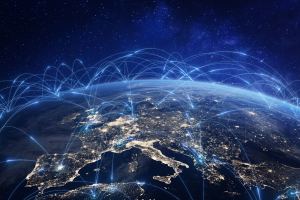IoT driven data and European Data Spaces
IoT provides a huge amount of data which can be harnessed to make industries more efficient and cost effective. How can we use and share this data effectively while keeping it secure?
What are Common European Data Spaces?
The European data strategy aims to make the EU a leader in a data-driven society. Part of this strategy is to establish EU-wide common, interoperable data spaces in strategic sectors for data sharing. Sectors include health, agriculture, manufacturing, energy, mobility, finance, public administration and mining. EU-wide common and interoperable data spaces aims to remove legal and technical barriers, thus unlocking the vast potential of data-driven innovation.
What is IoT?
IoT is a network of connected devices. IoT expands Internet connectivity into physical devices and everyday objects. These devices use electronics and internet connectivity to collect and share data, to communicate and interact with other devices over the Internet. They can be remotely monitored and controlled. IoT can be used for many applications depending on the industry and its objectives.
Cloud computing delivers computing resources and services on-demand over the internet. IoT and cloud computing complement each other, with cloud computing serving as the central hub for data storage and management in IoT systems.
IoT delivers real-time data making data-driven rapid and effective decision-making possible. Here are some examples of IoT used in different sectors.
IoT in healthcare
IoT is used is healthcare for remote monitoring using wearable devices, tracking of equipment, vehicles and medical staff, hand sanitisation. Remote patient monitoring works through IoMT (Internet of Medical Things) devices that collect patient data such as heart rate and body temperature. IoT devices tagged can be used to track real time location of medical equipment like wheelchairs, defibrillators, nebulizers, oxygen pumps and other monitoring equipment as well as deployment of medical staff at different locations. Healthcare Providers use IoT devices to remind people to sanitize their hands when they enter hospitals.
IoT in mining industry
In the mining industry, IoT is used as a means of achieving cost and productivity optimization e.g. using sensors on mining equipment and systems; improving safety measures e.g. monitoring ventilation and toxicity levels; and developing their artificial intelligence needs e.g. Using vast amounts of data inputs, from drilling reports & geological surveys, AI and machine learning can make predictions and provide recommendations on exploration, resulting in a more efficient process with higher-yield results.
IoT in energy industry
In the energy sector, IoT allows for more accurate communication between power stations, vital network nodes and the energy grid. IoT connects energy production, energy distribution and energy consumption to help manage demand and production more efficiently. Smart metering, energy monitoring, energy automation, energy consumption, energy prediction are all examples of how IoT can be used, The benefits of IoT in energy is improved energy efficiency and enhanced reliability of energy networks. IoT provides many possibilities to companies and smart homes looking for ways to achieve sustainability and energy efficiency.
IoT in agriculture
With a worldwide population predicted to be 9.5 billion by 2050, the agriculture Industry relies heavily on innovative ideas to address the growing demand for food. Examples of how IoT is used in agriculture is in monitoring climate and weather to predict rainfall, to select the right crops to grow. For crops, IoT agriculture IoT uses robots, drones, remote sensors, and computer imaging combined with continuously progressing machine learning and analytical tools for monitoring crops, surveying, and mapping the fields. The benefit of the data provided to farmers helps farm management and saves time and money.
RedZinc and IoT
RedZinc provides wearable devices for remote monitoring of patients outside the hospital via our signature cloud-based platform for hospitals and clinics called “BlueEye Virtual Wards”. Using this remote monitoring technology, a patient can be discharged early from the hospital or avoid admission by being monitored at home by the healthcare team. The wearable wireless vital signs IoT devices measure the patient’s vital signs automatically using Bluetooth and the wireless network at a hospital-grade level. IoT biometric devices in the BlueEye platform include ECG, respiratory and heart rate monitors for cardiovascular disease, oxygen saturation for respiratory disease, skin temperature and blood pressure. The data from the IoT devices goes automatically collected via Bluetooth through the BlueEye smartphone app near the patient and sent over wireless network to the monitoring clinical team. The patient data is kept secure and GDPR compliant through special end-to-end encryption, local data servers and dedicated routers.
RedZinc and European Data Spaces
RedZinc are working on European Data Spaces for the sake of patient data privacy. European Data Spaces for healthcare data gives much better protection to patient data than use of global hyperscalers for storage, transmission and where the data is being transmitted outside the EU. RedZinc platform BlueEye is a cloud-based platform with IoT devices which connect patients to clinical teams easily and securely and use the data to make efficient data-driven decisions to improve patient outcomes and healthcare system efficiency.
For more information voisit https://cop-pilot.eu
BlueEye Virtual Ward is an integrated care remote monitoring platform from RedZinc, consisting of wearable sensors, video technology and software platform to monitor and deliver care to the patients at home.
Contact us today at info@redzinc.net to discuss BlueEye virtual ward.


